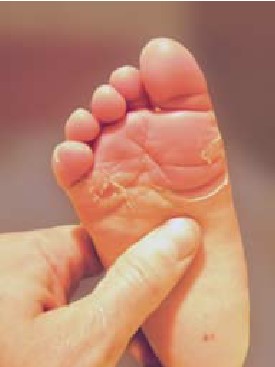(keratosis exfoliativa congenita, PSS)
Autosomal recessive transmission. Rare form of ichthyosis (see this term) clinically characterized by the appearance from early childhood of superficial and spontaneous desquamation of the skin, and histologically, by desquamation of the most superficial layers of the epidermis. It can present an acral distribution (acral PSS: MIM 609 796) or generalized (generalized type A (noninflammatory) or B (inflammatory) PSS.
Several mutations have been reported:
- mutations of the TGM5 gene (15q15) that codes for transglutaminase 5 (TGM5). TGM5 is expressed in the suprabasal layers of the epidermis and plays a role in the structural integrity of the upper layers of the epidermis.
- mutations of the NSDC gene (6p21.3) coding for corneodesmosine.
Acral PSS could be a genetically heterogeneous disease.
Acral form: shortly after birth or in early childhood, appearance of superficial peeling of palmar, plantar and dorsal face of the hands and feet areas, causing a residual painless erythema. Pieces of desquamed skin can easily be removed. There are seasonal variations. Heat, moisture, exposure to water and friction or minor injuries may cause or increase desquamation. The lesions are not painful and heal without scar.

Generalized PSS type A [MIM 616 265]: It manifests at birth or during early childhood. Significant exfoliation on the upper and lower extremities. Areas of hyperpigmentation may be observed. Contact with water, dust and sand may cause irritations. There is no history of erythema or atopy, and patients are generally in good health. Pruritus is rarely observed. The hair is normal.
Generalized PSS type B [MIM 270 300:] from birth or shortly thereafter, appearance of extensive asymptomatic, superficial and spontaneous painless skin peeling, consisting of white scales of variable size and shape that leave slightly erythematous bare areas with desquamative edges. Palmar and plantar areas are spared or present erythema, slight thickening of the skin or palmar hyperlinearity. An underlying erythroderma is present. Pruritus is common and often severe, and exacerbated by heat. In general, hair falls out more easily than normal (deficit of anchoring). Sometimes light to moderate nail abnormalities (koilonychia, onycholysis, thickening, yellow color of the nail bed). Atopic manifestations are frequent (food allergy, angioedema, urticaria and asthma) and Staphylococcus aureus infections have been reported. Patients are generally in good health but may present with growth retardation.
Anesthetic implications:
difficult fixation of the dressings to the skin (particularly for venous catheters); risk of atopy in case of type B form
References :
-
Updated: February 2018